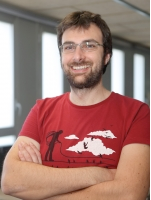Objectives
Abstract
How DNA is organized in three dimensions inside the cell nucleus and how this affects the ways in which cells access, read and interpret genetic information are among the longest standing questions in cell biology. Thanks to the advent of the so-called Chromosome Conformation Capture (3C) derived experiments, we now know that the genome is hierarchically organized into chromosome territories, sub-chromosomal compartments, Topologically Associating Domains (TADs), and globules. Based on few comparative studies, this hierarchical organization is acceptably considered as conserved in mammals. However, a systematic analysis on the evolution of the structure of genomes is still lacking.
We have generated new Hi-C interaction maps of 50 kb resolution for a panel of humans, primates (Gorilla, Chimpanzee, Orangutan, Gibbon, Macaque and Marmoset) and mouse. All Hi-C lymphoblast maps have been replicated using two biological samples per specie. Our results quantitatively relate genome divergence to the conservation of the four main levels structure organization of the genome (that is, chromosome territories, compartments, TAD borders and intra-TAD structure). First, the 3D genome organization seem to be maintained even after long distance chromosomal rearrangements. Second, the level of transcriptional activity (compartment type) is strongly conserved in syntenic regions. Third, TAD border conservation, although very strong, correlates linearly with sequence conservation. And fourth DNA sequence motifs recognized by the CTCF protein, a master regulators of the finer 3D organization of the genome (responsible of intra-TAD DNA loops), can be divided in categories depending on the presence of adjacent secondary motifs show different insulation powers. It also appears that the spread of these different categories of CTCF motifs is facilitated by different families of retrotransposons.
Short bio
 Francois Serra is a post-doc in the Structural Genomics lab of Marc A. Marti-Renom at CNAG-CRG. He obtained his PhD in evolutionary genomics under the supervision of Hernán Dopazo in 2012 studying correlated evolutionary pressure in functionally related group of genes and neutral models to explain the spread of genetic elements (mainly transposable elements) in eukaryotic genomes.
Francois Serra is a post-doc in the Structural Genomics lab of Marc A. Marti-Renom at CNAG-CRG. He obtained his PhD in evolutionary genomics under the supervision of Hernán Dopazo in 2012 studying correlated evolutionary pressure in functionally related group of genes and neutral models to explain the spread of genetic elements (mainly transposable elements) in eukaryotic genomes.
Francois is mainly interested in studying the effect of natural selection in new levels of genome organization. During his postdoc he first worked in the definition of a statistical and computational framework for the processing, analysis and comparison of structural genomics data. Work that resulted in TADbit framework for the treatment and analysis of Hi-C data. His main research is about comparative 3D genomics in primates, searching for common patterns and differences in the organization of our genomes.

Speakers
François Serra, post-doc in the Structural Genomics lab of Marc A. Marti-Renom at CNAG-CRG
